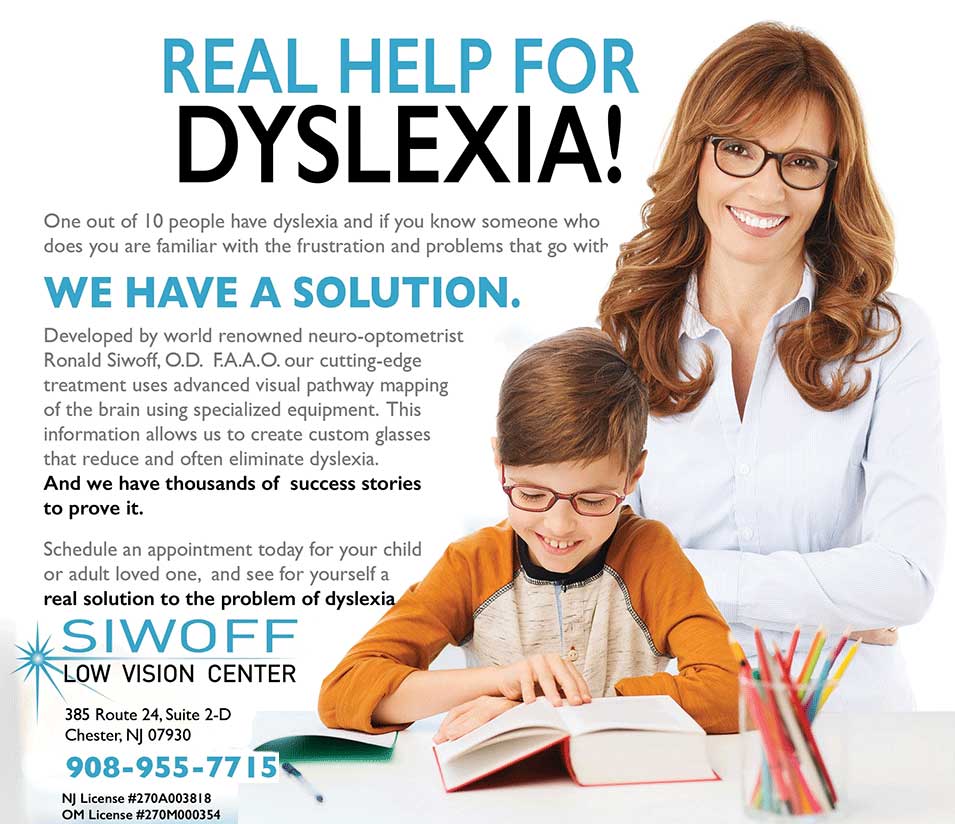DYSLEXIA DIAGNOSIS AND TREATMENT
The National Institute of Neurological Disorders and Stroke (May 12, 2010) described dyslexia as a neurological disease that affects learning.
Understanding the causes and treatment for other neurological diseases impacting vision led us to a similar treatment for dyslexia by improving reading speed and comprehension over a very short period of time. Therapy can be as simple as wearing the prescribed eyeglasses and reading on a daily basis. Our ongoing research with a large sample of patients has demonstrated that ophthalmic prisms can change VEP latencies and improve visual acuity and function over and above conventional spectacle prescriptions. This method also has applications for anyone with mild to severe alexia caused by cortical damage or optic nerve disease.
Our treatment of dyslexia is a new discovery that has resulted from our decade-long study of neuro-stimulation for patients suffering from neurological loss of vision. The breakthrough occurred when we noted a link between stroke and dyslexia. In screening, both groups of patients are unable to touch the end of a penlight with one finger when asked. No matter how many times the task is presented practice does not improve errors in touching the penlight. This clinical sign is referred to as past-pointing, and is recognized by neurologists as a potential sign of neuro-processing delays. We have found that screening for past-pointing is an excellent tool for identifying children and adults with dyslexia. VEP (Visual Evoked Potential) electrodiagnostic testing of these individuals almost always shows further evidence of latencies (lateness) in receiving visual information.
Past-pointing Pre-Test (you can do at home)
Siwoff Low Vision Center has helped many children and adults who have reading concentration issues, and we would love to help you as well. This test is designed to determine if a person is a candidate for our work.
The past-pointing pre-test requires that the tester hold a penlight or pencil in four positions around a person’s head: upper-right, upper-left, lower-right, and lower-left. It is important that, before presenting the pencil / penlight to the person, you start by holding it down by your side first. DO NOT swing it across like a paint brush, because this will give the person an indication of its final destination. When you hold the pencil or flashlight, lift it from your side and only hold it up long enough to silently say “Mississippi”. If you hold it up longer, everyone will touch it and the test is not valid. Failure at this test indicates that we may be able to help. The definitive tests are done with our technology.
Note: This test is only for the purposes of checking on a child or adult who has reading concentration issues. There are other diagnoses and complaints that can be treated at our center, but we would not use this test to evaluate if a patient should be seen. Usually, parents or patients know if they have a serious vision problem, such as nystagmus, corneal problems, retinal problems, etc., and those who are seriously visually impaired are helped by our doctor through other treatments.
Evolution of Our Research
In 1672, Sir Isaac Newton first described the prism as an afocal optic, which means it does not produce an image; it only bends light. Prisms have been used in telescopes, binoculars, microscopes, and glasses ever since Sir Isaac Newton. What was not known is that prisms produce changes in neuroprocessing speeds. They are the equivalent of a resistor in an analog circuit, which produces a shift in the wave, making it faster or slower. Similarly, prisms produce a shift in latency in the visual system, making the signals faster or slower. The shift is caused by a change in direction and / or the amount of the prism. This shift has been proposed to be caused by the Stiles-Crawford Effect, which has shown directional sensitivity of individual photoreceptors. Whether the effect is retinal or neuro-anatomical, the effects are objectively measurable with our technology.
Objects, pictures, symbols, everything we see travels as light through the lens of the eye where it is focused on the retina, and thereby converted into analog electrical signals. These signals travel through the brain and arrive at the primary visual cortex in about 100 milliseconds. Although our dyslexia patients have normal vision, they have positive neurological signs and abnormal signals traveling through their brain, which slows the arrival of the signals from the eye. In a person with dyslexia, signals often take 115 to 140 milliseconds to arrive at the primary visual cortex. This represents a significant delay of fifteen to forty percent, which causes the processing difficulties that people with dyslexia experience. The delays in processing are detected and measured with Visually Evoked Potential (VEP) testing. Our outcomes suggest that when responses to signals are delayed, Wernicke’s area cannot process the information needed to convert the signals into words and sentences, and therefore reading effectively is very difficult and sometimes impossible.
Ophthalmic prism has been used for decades to reposition retinal images by moving the angle of light entering the eye. We have made a major discovery in finding another important and even more applicable use of ophthalmic prism, and that is to speed up the individual’s receiving of visual information. Speed of seeing is crucial to many visual demands in everyday life, particularly in the ability to read.
The specially designed and individualized prescriptions for prism glasses, based on results from the VEP, as well as the entire comprehensive eye exam, substantially correct the patient’s/student’s latency problems. Immediate evidence from trial lenses used during the first exam shows absence of past-pointing and improved speed of reading. The level of advancement of the student will depend on his overall learning potential, as well as attention, motivation, auditory processing, etc.
Our research and that of our colleagues in neurology shows that there is a six-week period of adaptation and growth after the patient/student begins wearing the glasses. Visual learning skill development requires that the student wear the glasses at all waking times, and not repeatedly take them on and off. The brain cannot adapt well to inconsistency of visual-directional stimuli.
If the student has difficulty accepting the glasses, therapists will need to create a desensitization module, with acceptance as the first objective in the individual Educational Plan.
Our consultant services include a licensed cognitive-behavioral therapist with a background working with special needs children and adults. Please do not hesitate to contact us for help with classroom activities to enhance visual and behavioral function.
Below you’ll find correspondence with a school professional about a child with dyslexia and vision problems. We provide support services and counseling at no charge to our patients, their families, and their schools.
From: K.M., School Psychologist
 Dear Rachel-Rose,
Dear Rachel-Rose,
Thank you so much for your time and expertise today!
Your consultation was very helpful. The following are a few notes that I took during our phone consultation, as I await your email confirmation:
As discussed, N’s vision as relates to diagnosis, impacts fluidity of reading. Use of magnifying devices inevitably lends itself to isolation of letters and words, reducing fluidity.
A critical period of adjustment to new lenses/prism glasses, correspondingly, improved fluidity of reading, is anticipated. Reading practice for thirty minutes a day is recommended particularly during that time.
I appreciate the idea that N’s tolerance must also be carefully considered to maintain his therapeutic participation.
I look forward to consulting again, following N’s next check-up and also visiting your office in the near future.
Sincerely,
Kristine
Dear Kristine,
From our phone conversation today, I greatly appreciated your very intelligent and caring attention to N’s needs. As a school psychologist, I think you are a credit to your excellent school system.
You have well noted our discussion on N’s diagnosis of optic nerve hypoplasia. It does impede reading cadence. However, the custom-prescribed prismatic reading glasses, which are on order, are expected to significantly reduce the problem by increasing smoothness of reading. You are also correct about the magnifying devices. Although they help individuals with N’s problems see letters and words more boldly and clearly, they do not permit as wide a view of reading material as the glasses and the techniques we recommend. We will dispense instruction materials at the time that N receives his reading glasses.
I do want to add a precaution to everyone who monitors N’s reading practice, whether teachers, aides or family members, and that is that we do not want our patients (students) to become self-conscious. People who have people standing over them, for example, taking a test, typing a letter, playing the piano, are well aware of the propensity for increased nervousness and errors. All educational staff and family are advised to encourage and reinforce day-to-day progress.
As an aside, we have found that a metronome or similar device, when used correctly and incrementally, can help to teach a smoother reading style. In the end, we want N to like to read, because in the future he will be reading to himself more than reading aloud to others. We want him to read a lot in the future, and we do not want him to become self-conscious and/or discouraged early in his educational development.
I hope this clears up any questions that you and your IEP team may have.
Best regards,
Rachel-Rose Siwoff, MA-LPC, BCPC
Board Certified Counselor, American Psychological Association
And here’s a testimonial from one of our patients whose children we have worked with…
Dear Dr. Siwoff,
Since I have had such an amazing experience with our children after seeing you, …, I have felt the need to share our amazing success with others. I have been calling around to schools … spreading the word of my success story. I have slowly been getting many phone calls from desperate parents which have heard about your practice and learned that I too have been helped.
There are unfortunately too many children and teenagers suffering with similar reading issues struggling to keep up to par in school. Many parents have told me the stories of their teenagers ready to give up in … schools because they are already burnt and it is too difficult with them.
I feel that since I was granted this amazing gift for my children they have gone from hating to read to loving it- from struggling academically to being considered top of the class I would like to help others too.
-F.Q.


